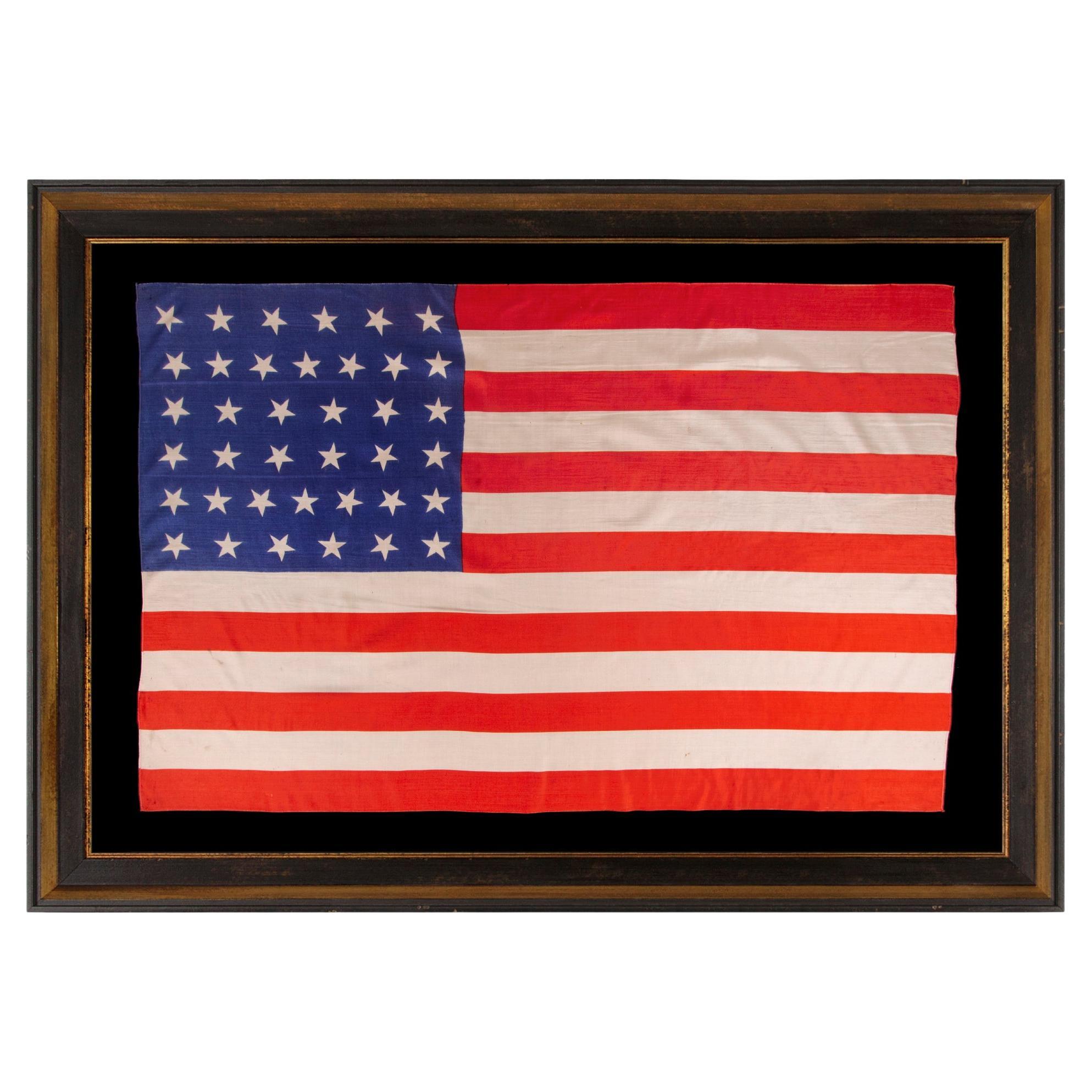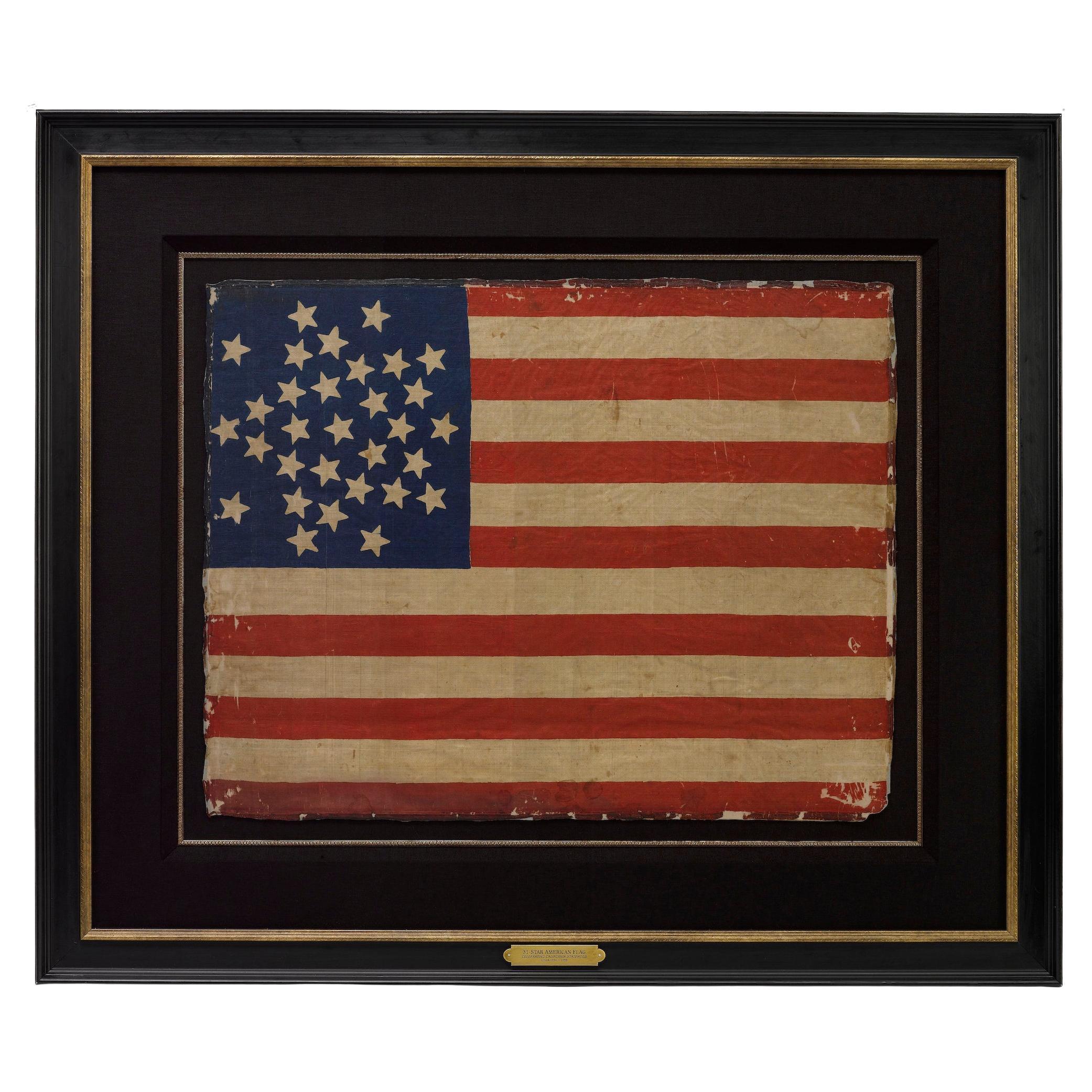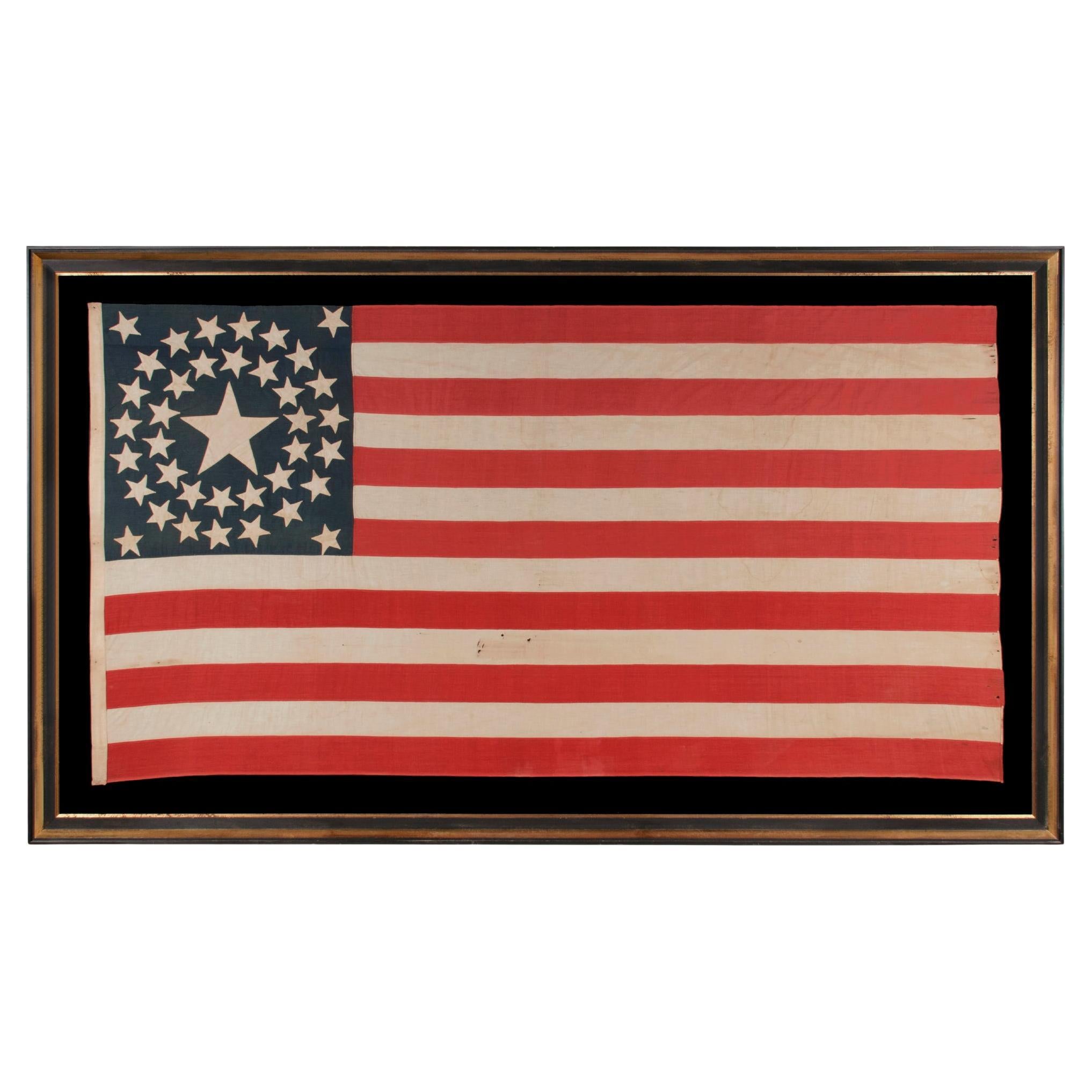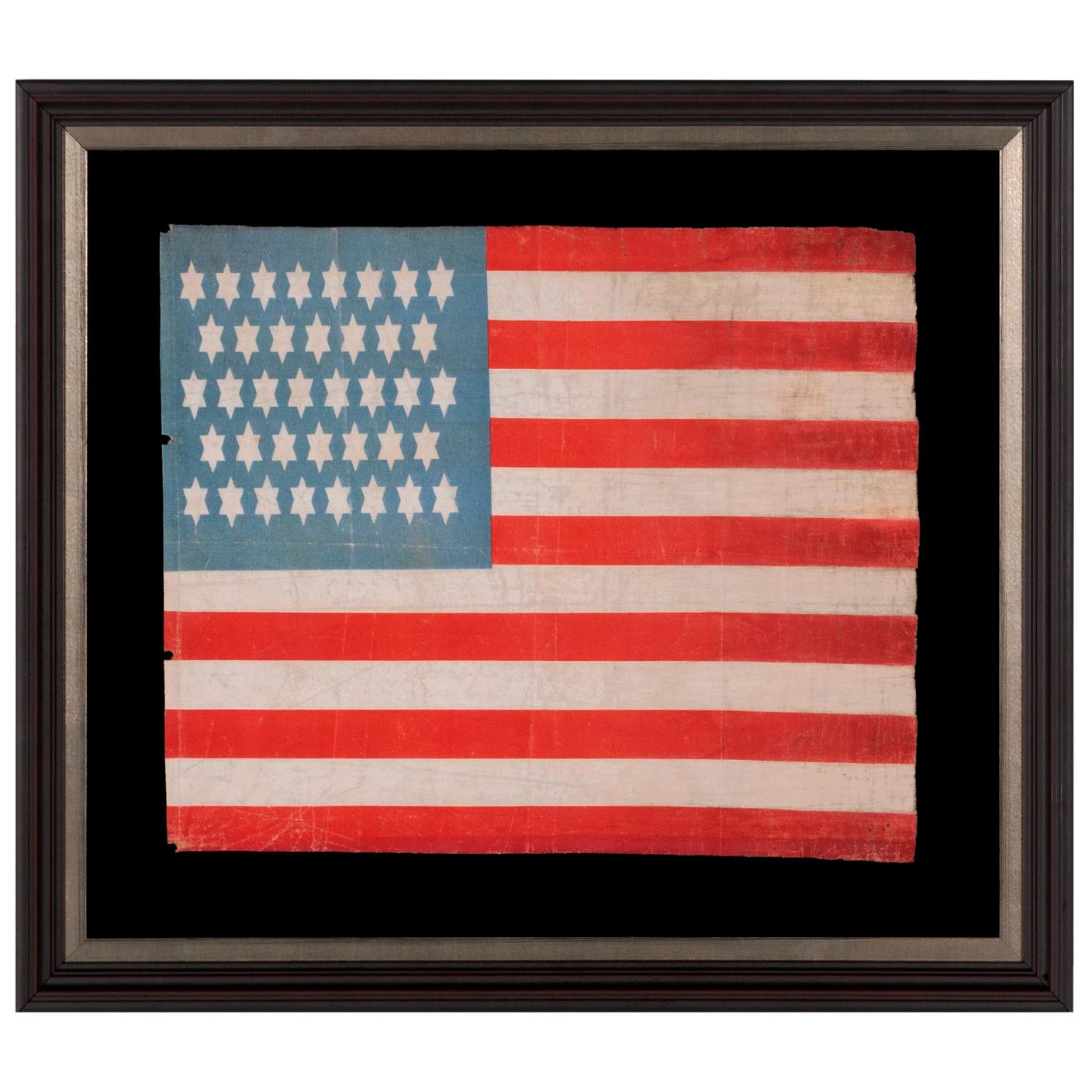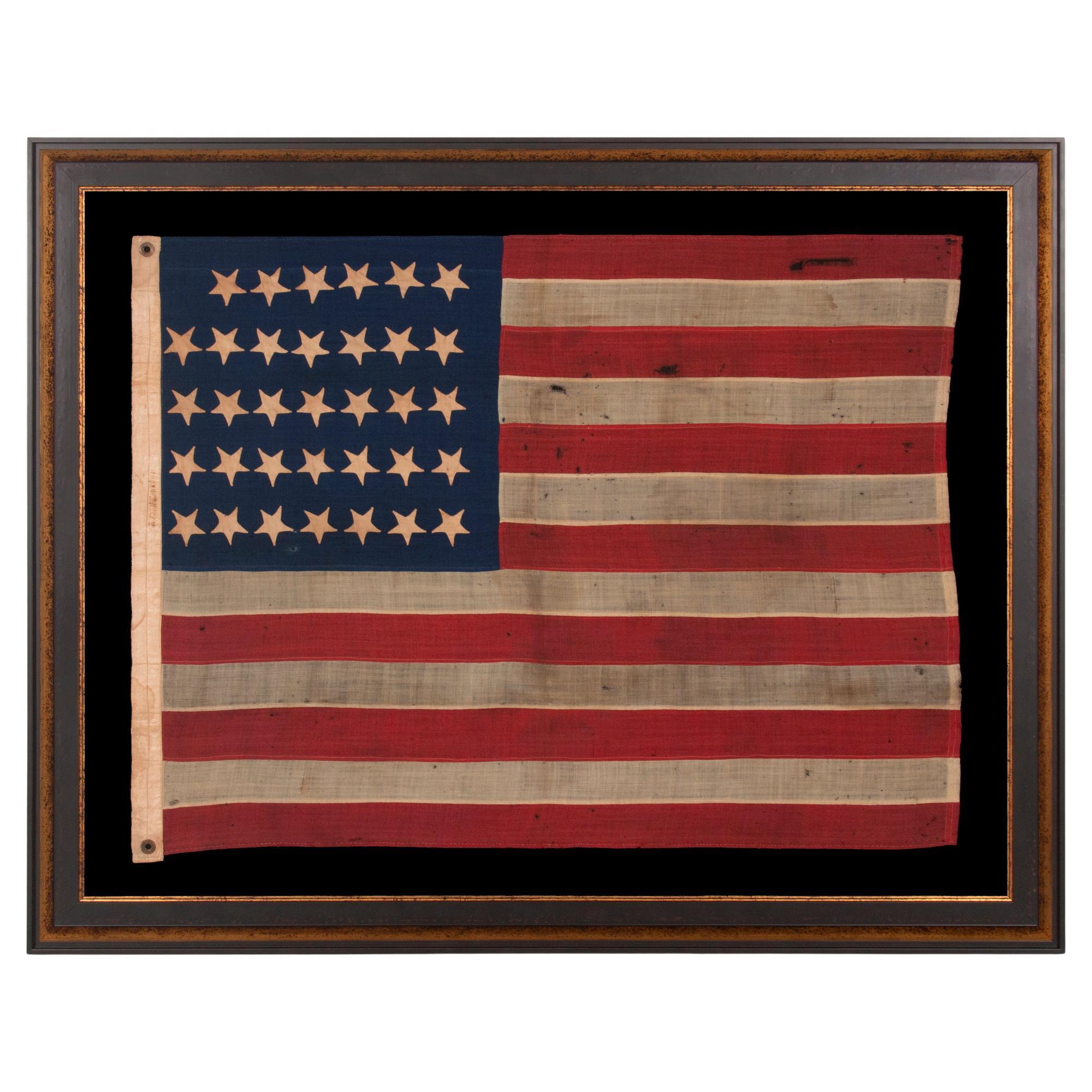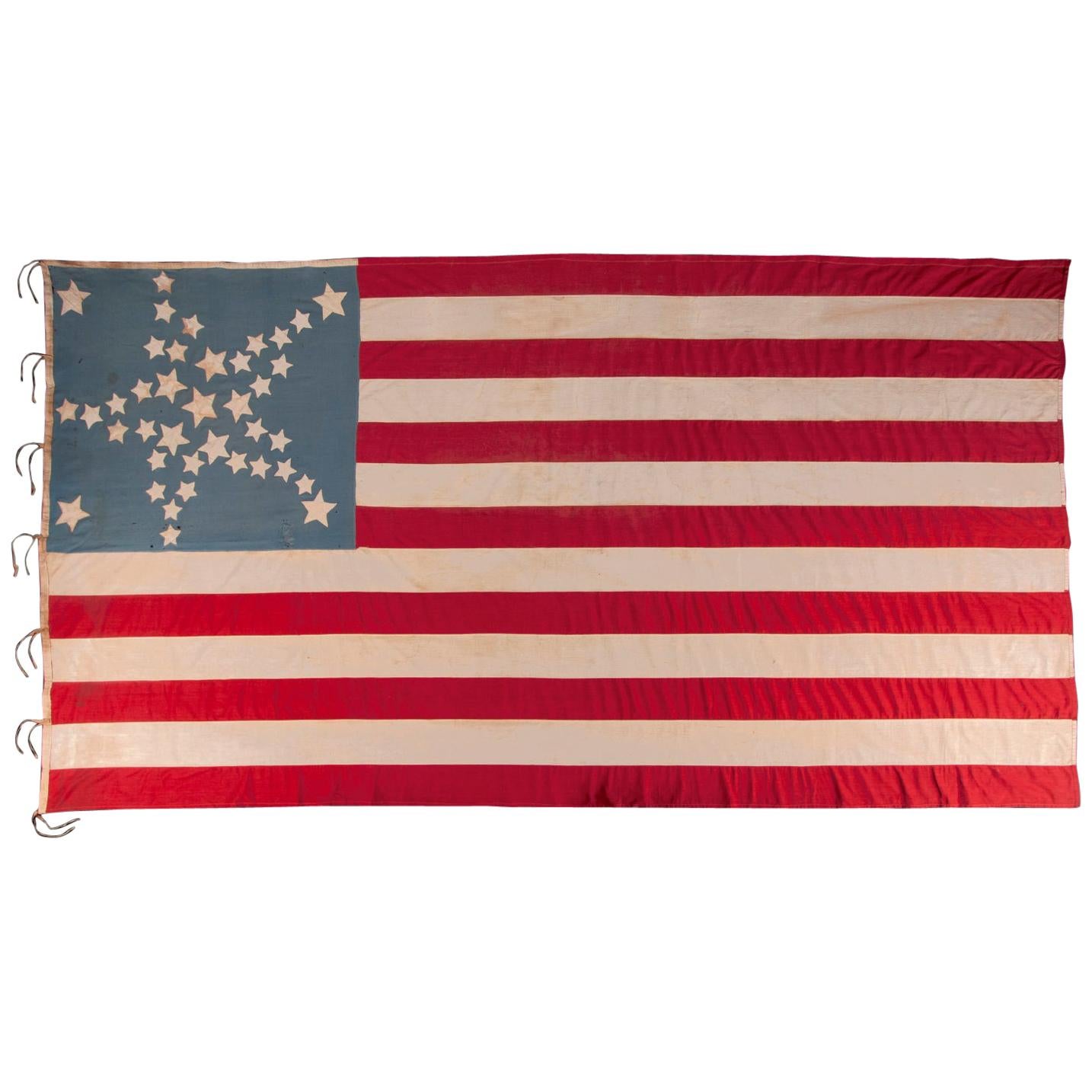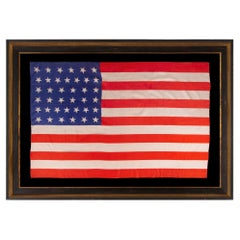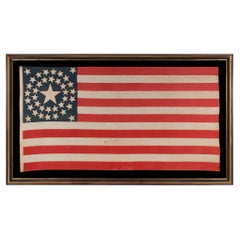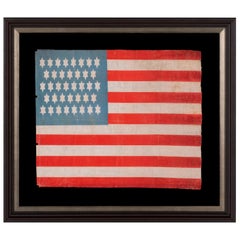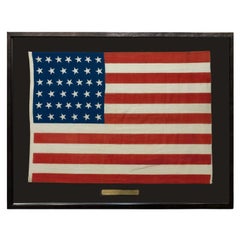Items Similar to Antique American Flag, 32 Stars, Minnesota Statehood, circa 1858-59
Want more images or videos?
Request additional images or videos from the seller
1 of 10
Antique American Flag, 32 Stars, Minnesota Statehood, circa 1858-59
About the Item
32 STARS IN A VERY UNUSUAL NOTCHED VERSION OF THE “GREAT STAR” PATTERN, WITH TWO STARS ABSENT AT THE EXTREME POINTS OF EACH ARM, MADE IN THE PERIOD WHEN MINNESOTA JOINED THE UNION AS THE 32ND STATE; A VERY RARE STAR COUNT, OFFICIAL FOR JUST ONE YEAR, AND ACCURATE FOR JUST NINE MONTHS, 1858-1859
32 star American national flags are rare. This is largely because they were only official for one year (1858-1859), but it is also a result of the fact that this time frame occurred prior to the American Civil War (1861-1865), in an era when use of the Stars & Stripes on land in the private sector fell somewhere between slim and non-existent.
Minnesota joined the Union as the 32nd state on May 11th, 1858. The 32-star flag became official less than two months later, on July 4th, and remained so until July 3rd, 1859. In the meantime, Oregon was admitted as the 33rd state.
According to legislation enacted by Congress on April 4, 1818, stars were to be added on Independence Day each year, following the addition of any incoming states. Commercial flag makers paid little heed to such requirements, however, because it made little in the way of practical sense. On one hand, flag-makers sought reasons to produce new flags, in order that they have something new to sell. They also wanted to be a step ahead of their competitors. At the same time, potential buyers of flags would not want to acquire them with a smaller number of stars than the actual number of states at the time, since the impeding addition of the respective stars was inevitable. For these reasons, and in the spirit of American expansionism, especially popular during the settling of the American West that was under way, flag-makers would add stars as soon as a state was in, or in some cases even beforehand, in anticipation of impending statehood of another Western Territory. The same would have been true in homemade flags, where, in addition to being practical, legislation surrounding the official date for the addition of stars was probably not common knowledge. Almost no one knows this today, for example, unless they are intimately involved in Vexillology, and during the 19th century it may not have even been commonly known among most flag-makers, who were often cottage industry sailmakers or producers of tents and awnings, and probably unfamiliar with decades-old flag legislation.
For the above reasons, production of 32 star flags would have ceased with the addition of Oregon on February 14th, 1859, well before July 4th. This meant that the 32 star count would have only seen use for about 9 months, making it one of the shortest lived flags in early America.
This particular 32 star American national flag was found in the attic of a home in Minnesota when it passed to the new owners many years ago. With its strong colors and intriguing presentation of stars, is one of the few examples known to survive from this exceptionally narrow window of time. I am aware of about 10 known examples with pieced-and-sewn construction, among which this is one.
Made of cotton, hand sewn, and double-appliquéd (applied to both sides), the stars of the flag are arranged in a variation of what is known as the “Great Star” pattern, one large star, made out of smaller ones. This particular version of the Great Star is highly unusual, because 2 of the stars that should be present in the canton, in the extreme position at the end of two of the arms, (directed at 12:00 and approximately 5:00,) are absent. This results in a feature that is referred to as a “notched” design, which allows space for the addition of more stars.
In some Great Star patterns, stars are present outside the primary design. For example, there might be a Great Star in the center, flanked by a single star in each corner of the blue canton. In rare instances, one might see this sort of pattern, but with only 2 stars outside the Great Star, in the upper and lower hoist-end corners, leaving two spaces open along the fly-end side.
Another method of leaving additional space is obvious gaps near the center of the star shaped profile, but that is not present on the flag that is the subject of this narrative. Note that this flag displays a larger star in the center, surrounded by a rather tight wreath of 8 stars, which, on careful inspection, is flanked by 5 individual stars at evenly spaced intervals. This actually creates a Great Star pattern of its own, in a design that I call a “circle-star,” comprised of 14 stars in total. 18 more stars, placed around this neatly ordered pattern, form the incomplete star shaped and bring the total to 32. Unique to this flag among known examples, I cannot recall ever having seen intentional notches at the end of the arms of a Great Star.
On the obverse (front), the large center star and one of the stars adjacent to it are hand sewn. On the reverse, 21 of the stars, including the large center star, are hand sewn. The remainder were appliqued with treadle stitching. The canton is made of Fine merino wool. Due to the scale of the flag, this was pieced from two lengths of blue fabric, which were joined by hand-stitching. The stripes of the flag are made of cotton and are treadle-sewn. At the end of the 3rd white stripe, on the obverse, is a maker’s or merchant’s block-printed stamp with the numeral designation “533” surrounded by fanciful scrollwork. Rendered in red ink or pigment, this probably relates to the manufacturer or seller of the cloth and specified the yardage (or meters) on the particular bolt. Whatever the case may be, it is a very uncommon feature.
There is a coarse, sailcloth canvas binding along the hoist end. I suspect that this was taken off and then re-applied during a repair. The top of the canton was damaged near the hoist. Two patches were added at this time. One, made of dark blue, plain-weave cotton, is adjacent to the fly end and effectively acts as a gusset, (a reinforcement patch, typically original to the construction of a utilitarian textile,) though it does not connect with the top edge of the canton. The other patch, made of glazed blue cotton chintz, is slightly further down and reinforces a tear. The top edge of the canton was folded over and bound with a row of treadle stitching at the time. In the region from the hoist binding to the end of the second patch, the selvage along the top edge of the canton is absent, but it is present beyond that point. The fly end was bound with a length of red cotton, seemingly the same as was employed in the stripes. Applied bindings along the top, bottom, or fly are encountered in flags of this era, but they are not common. I suspect that this one may have been added during the repair, at which time the flag may have been shortened slightly. The amount does not appear to have been significant, perhaps consisting of about two to four inches. This was the proper and expected. There were no official proportions for the American national flag until 1912. The stitching of the hoist and fly ends and the top of the canton are executed with treadle stitching and I expect that the maker of the flag may have been responsible for its repairs, as evidenced by the same, tight stitching. The dark blue patch was certainly added after the first, as it is applied over the one made from cotton chintz.
There is a penciled inscription on the reverse of the hoist binding, near the bottom, which includes the initials “E.H.” followed by what appears to be “Husted,” followed by the letter “y” or the letter “r.” If the latter is true, the name may be “Husteder,” but the writing is loosely defined and very faint. Whatever the case, this would be the name of a former owner and it was common to mark flags in this manner during the 19th century. Initial research into this name turned up nothing of interest. Such circumstance is not uncommon with regard to names present on early flags. Although I have become rather good at deciphering the characters when poorly written or faded, the information is typically too vague to yield meaningful results.
Flags made prior to the Civil War (1861-1865) are extremely scarce, comprising less than one percent of 19th century flags that have survived into the 21st century. Prior to the Confederate attack on Fort Sumter in 1861, the Stars & Stripes was simply not used for most of the same purposes we employ it in today. Private individuals did not typically display the flag in their yards and on their porches. Parade flags didn't often fly from carriages and horses. Places of business rarely hung flags in their windows. The only consistent private use prior to 1861 seems to have accompanied political campaigning.
Even the military did not use the national flag in a manner that most people might think. Most people are surprised to learn that the infantry wasn’t authorized to carry the Stars & Stripes until well into the 19th century, and even then did not often exercise the right, because it was neither required nor customary. The foremost purpose before the Mexican War (1846-1848) was to identify ships on the open seas. While the flag was used to mark garrisons and government buildings, the flags of ground forces were limited to the those of their own regiment and a perhaps a Federal standard (a blue or buff yellow flag bearing the arms of the United States). Artillery units were the first to be afforded the privilege in 1834. Infantry followed in 1841, but cavalry not until 1862.
Mounting: Conservation mounting and framing is included, to be complete by our own conservation department, which is led by expert staff. We take great care in the mounting and presentation of flags and have preserved thousands of examples.
Condition: In addition to the repairs mentioned above, there is a stitched repair in the top red stripe (which we will remove when mounting). A seam was added to repair a tear at the fly end of the last red stripe, in which there is also a modest hole near the fly end, in addition to some very minor ones elsewhere, and a tear along the bottom edge. There is very minor foxing and staining throughout. Many of my clients prefer early flags to show their age and history of use.
Frame size (H x L): Approximate 76.5" x 112"
Flag size (H x L): 63.75" x 99.5".
- Dimensions:Height: 76.5 in (194.31 cm)Width: 112 in (284.48 cm)Depth: 2.5 in (6.35 cm)
- Materials and Techniques:
- Place of Origin:
- Period:
- Date of Manufacture:1858-1859
- Condition:See Item Description.
- Seller Location:York County, PA
- Reference Number:Seller: 32j-8111stDibs: LU849719981012
About the Seller
5.0
Recognized Seller
These prestigious sellers are industry leaders and represent the highest echelon for item quality and design.
Established in 1991
1stDibs seller since 2008
69 sales on 1stDibs
Typical response time: 8 hours
- ShippingRetrieving quote...Shipping from: York County, PA
- Return Policy
Authenticity Guarantee
In the unlikely event there’s an issue with an item’s authenticity, contact us within 1 year for a full refund. DetailsMoney-Back Guarantee
If your item is not as described, is damaged in transit, or does not arrive, contact us within 7 days for a full refund. Details24-Hour Cancellation
You have a 24-hour grace period in which to reconsider your purchase, with no questions asked.Vetted Professional Sellers
Our world-class sellers must adhere to strict standards for service and quality, maintaining the integrity of our listings.Price-Match Guarantee
If you find that a seller listed the same item for a lower price elsewhere, we’ll match it.Trusted Global Delivery
Our best-in-class carrier network provides specialized shipping options worldwide, including custom delivery.More From This Seller
View All32 Star Antique American Flag, Minnesota Statehood, Extremely Rare, 1858-1859
Located in York County, PA
32 STAR ANTIQUE AMERICAN FLAG OF A TYPE KNOWN TO HAVE LIKELY SEEN MILITARY USE, REFLECTS THE ADDITION OF MINNESOTA TO THE UNION IN 1858, AN EXTREMELY RARE FLAG, ACCURATE FOR JUST 9 MONTHS AND OFFICIAL FOR ONLY ONE YEAR
32 star American flags are rare. This is largely because they were only official for one year (1858-59), but it is also a result of the fact that this time frame occurred prior to the Civil War, in an era when use of the Stars & Stripes on land in the private sector was very slim. Flags were becoming popular in political campaigning, but their use had yet to become widespread in the display of general patriotism.
Minnesota joined the Union as the 32nd state on May 11th, 1858. Following the Flag Act of 1818, stars were officially added to the American flag on the 4th of July following a state's addition, for any states that entered during the previous “flag year.” The 32 star flag...
Category
Antique 1850s American Political and Patriotic Memorabilia
Materials
Cotton
38 Star Antique American Flag, Colorado Statehood, circa 1876-1889
Located in York County, PA
38 star antique American parade flag with scattered star orientation, made of silk, with generous scale and vivid colors, Colorado Statehood, 1876-1889
38 star American national p...
Category
Antique Late 19th Century American Political and Patriotic Memorabilia
Materials
Silk
Price Upon Request
38 Star Antique Flag, Stars in Double Wreath Pattern, Colorado Statehood 1876-89
Located in York County, PA
38 STAR ANTIQUE AMERICAN FLAG WITH A DOUBLE-WREATH CONFIGURATION THAT FEATURES AN ENORMOUS CENTER STAR, REFLECTS THE PERIOD OF COLORADO STATEHOOD, 1876-1889:
38 star American national flag, made entirely of plain weave cotton. The stars are arranged in a medallion configuration. This features an enormous center star, surrounded by two wreaths of much smaller stars, with a flanking star in each corner of the blue canton. The sort of disparity here, present in the scale of the large star, versus those around it, is both exceptionally unusual and graphically dynamic.
Colorado became the 38th state on August 1st, 1876. This was the year of our nation’s centennial. Per the Third Flag Act of 1818, stars were not officially added until the 4th of July following a state's addition. For this reason, 37 remained the official star count for the American flag until part way through the following year. Flag-making was a competitive venture, however, and few flag-makers would have continued to produce 37 star flags when their competitors were making 38’s. Many flag-makers added a 38th star before Colorado entered the Union, in the early part of 1876, or possibly even prior. In fact, many makers of printed flags, called parade flags or hand-wavers, were actually producing flags in the 39 star count, in hopeful anticipation of the addition of two more Western Territories instead of one.
It is for these reasons that 38, 39, and 13 stars, to representing the original 13 colonies, are most often seen on flags displayed at the Centennial International Exhibition. Hosted in Philadelphia, this enormous event was our nation’s first World’s Fair, lasted for a duration of six months, and served as the nucleus of celebrations held to honor America’s 100-year anniversary of independence. The 38 star flag became official on July 4th, 1877 and was generally used until the 39th state was added in November of 1889.
This is probably a homemade flag, though sewn by a very skilled hand, or possibly, by two different individuals. The stripes are pieced and sewn entirely by hand, with remarkable care and precision. The canton is constructed of two lengths of blue fabric, that have been joined with treadle stitching. This was joined to the striped field by hand. The stars are double-appliquéd (applied to both sides) with treadle stitching. There is a treadle-sewn, cotton binding along the hoist, with five, hand-sewn grommets.
It is extremely unusual to encounter this combination of sewing methods. Soon after the sewing machine was mass-marketed, in the mid-1850’s, flag-makers both public and private made good use of treadle machines, to join stripes, when constructing American flags. During the Civil War (1861-65), most stripes were treadle-sewn. Stars were another matter. Until the advent of electric machines...
Category
Antique Late 19th Century American Political and Patriotic Memorabilia
Materials
Cotton
38 Star Parade Flag with Whimsical 6-Pointed Stars, Colorado Statehood
Located in York County, PA
38 WHIMSICAL STARS, WITH 6-POINTED PROFILES, SIMILAR TO THE STAR OF DAVID, ON AN ANTIQUE AMERICAN FLAG OF THE CENTENNIAL ERA; A REMARKABLE SPECIMEN, ONE-OF-A-KIND AMONG KNOWN EXAMPLE...
Category
Antique Late 19th Century American Political and Patriotic Memorabilia
Materials
Cotton
Price Upon Request
34 Star Flag with Upside down Hand Sewn Stars, Kansas Statehood, circa 1861-1863
Located in York County, PA
34 Upside-down, Hand-sewn Stars In A Notched Configuration, On An Antique American Flag Of The Civil War Period, With A Beautiful And Highly Unusual Jacquard Weave Binding, And In A Tiny Scale Among Its Counterparts, Reflects The Addition Of Kansas As The 34th State, 1861-1863
34 star American national flag with a number of interesting and desirable features. Chief among these is the scale of the flag among counterparts of the period. At just three by four feet, its size is absolutely tiny among those with pieced-and-sewn construction. During the 19th century, sewn flags (as opposed to those that were printed on cloth) were typically eight feet long and larger. This is because they were important in their function as signals, meaning that they needed to be seen and recognized from great distance. A flag that was six feet in length was considered small and production of flags smaller than this was extremely limited. Even infantry battle flags, carried on foot, were approximately six by six and-one-half feet, about the size of an average quilt of the same period. It wasn't until the 1890’s that manufacturers began to produce smaller sewn flags in great quantity.
The stars of the flag are arranged in justified lineal rows, the first of which contains one fewer star. This results in what I call a “notched” design, leaving one space open for the addition of another star. The blank space leaves little doubt that the maker of the flag assumed that another Western Territory would soon acquire statehood, or that West Virginia might soon break free from Virginia, which occurred in June of 1863.
Note how the stars are oriented so that they are upside-down on their vertical axis, with two points up instead of one. No one knows if this positioning bore any particular meaning. Both modern notions of the correct orientation of a star, and the present official design of the American flag, dictate that the stars are supposed to have one point up. Since there was no official design for the flag until 1912, however, it may simply be that the maker of the flag did not consider any particular position to be right-side-up or upside-down. In the mid-19th century, it was not uncommon to see stars pointing any which way, varied throughout whatever arrangement was chosen. Whatever the case may be, the feature present on this particular flag is unusual to the eye and notable in terms of its presentation.
Made of cotton, the stars are hand-sewn and double-appliquéd (applied to both sides). The canton and stripes of the flag are made of wool bunting. Because blue wool bunting generally came in a width of 18", the canton was pieced from two lengths of fabric, joined by hand-stitching. The canton is joined to the striped field by hand-stitching. The stripes are pieced and hemmed by treadle stitching.
Made of heavy, polished, jacquard weave linen, the binding of the flag is both exceptional from a textile connoisseur’s perspective and highly unusual. This is joined to the flag by treadle stitching. There are two brass grommets, one each at the top and bottom of the hoist, which are likewise especially unusual, in that they are both heavier than normal and intentionally hammered flat. I have seen this on only one other occasion in a Civil War flag...
Category
Antique Late 19th Century American Political and Patriotic Memorabilia
Materials
Wool
45 Stars Antique American Parade Flag, Utah Statehood, ca 1896-1908
Located in York County, PA
45 STAR ANTIQUE AMERICAN PARADE FLAG WITH ITS STARS ARRANGED IN A NOTCHED PATTERN, 1896-1908, UTAH STATEHOOD:
45 star American national flag, printed on coarse, glazed cotton. Evide...
Category
Antique 1890s American Political and Patriotic Memorabilia
Materials
Cotton
Price Upon Request
You May Also Like
31-Star Printed American Flag, Celebrating California Statehood, Circa 1850
Located in Colorado Springs, CO
This is a rare 31-star medallion printed American flag, celebrating the addition of California to the Union. The flag is printed on silk and has a spectacular “Great Star” canton pat...
Category
Antique 1850s American Political and Patriotic Memorabilia
Materials
Silk
38-Star Antique American Flag with Unique Canton, circa 1876-1890
Located in Colorado Springs, CO
This is a striking 38-star American flag. The flag dates to 1876-1890, when Colorado (represented by the large star in the center of the flag’s canton) joined the Union as the 38th s...
Category
Antique Late 19th Century American Political and Patriotic Memorabilia
Materials
Muslin
39-Star Antique American Flag with 'Whimsical' Star Pattern, 1889
Located in Colorado Springs, CO
This is a 39-star unofficial American flag, handmade and printed on cotton. The flag dates to 1889 and has a unique history, thanks to its rare star-count.
The flag’s canton is prin...
Category
Antique 1880s American Political and Patriotic Memorabilia
Materials
Cotton
Antique Federal Eagle American 50 Star Flag with Brass Eagle Pole, 19th Century
Located in Oklahoma City, OK
Monumental 50 star American Flag with antique Federal Eagle brass and wood pole. A patriotic piece suitable for any home. This set includes both ...
Category
Antique 19th Century American Federal Political and Patriotic Memorabilia
Materials
Brass, Bronze
$4,800 Sale Price
20% Off
46-Star American Flag Printed in Drum Star Configuration
Located in Colorado Springs, CO
This is an original 46-Star American parade flag, celebrating Oklahoma statehood. Each star on the flag's canton represents a state in the Union at the time. The official flag design would update every July 4th, to include any new states added to the Union in the past year. Oklahoma, the 46th state, entered the Union on November 16, 1907. As such, this 46–star flag was the official flag of the United States from July 4, 1908, until July 4, 1912.
The silk flag has a dark blue canton with 46 white printed stars. The stars are printed in an 7-8-8-8-8-7 row configuration, or “Drum design.” The flag design is completed with 13 alternating red and white stripes, each stripe representing one of the original thirteen colonies.
The land that comprises Oklahoma today was added to the United States as part of the Louisiana Purchase of 1803. Throughout the 19th century, the U.S. government relocated Indian tribes from the southeastern United States to the area, and by 1900, over 30 Indian tribes had been moved to what was originally called the Indian Territories. At the same time, ranchers in Texas began to move into the area in search of new pasture lands. Although stipulations in the Indian Relocation Act agreed that the land would forever be Indian Territory, the promise of fertile farmland trumped the government’s promise of sovereignty.
On April 22, 1889, they opened the land to settlement by homesteaders, creating a land run in which settlers, called “Boomers,” were allowed to cross the Texas or Arkansas border at a particular hour to claim homesteads. Settlers who illegally crossed the border earlier to stake prime land were called “sooners,” which eventually became the state’s nickname. Wagons and the Santa Fe railroad carried cartloads of men and women to blank town sites and building plots, creating ten thousand-people communities in a matter of days. The following year, the region was further divided into Indian Territory and Oklahoma Territory...
Category
Vintage 1910s American Political and Patriotic Memorabilia
Materials
Silk
King Edward VII Coronation, June 1902 Framed Red Flag
Located in Hastings, GB
King Edward VII coronation, June 1902 framed scarf / flag.
This scarf is an original antique piece of British history and patriotic memorabilia.
...
Category
Antique Early 1900s British Edwardian Political and Patriotic Memorabilia
Materials
Cotton
Recently Viewed
View AllMore Ways To Browse
United States Congress
American West Antiques
Antique Cotton Scale
Antique Political Print
Mounted American Flag
American Flag Framed
Framed American Flags
19th Century American Flag
Folk Art American Flag
Parade Flag
Antique American Flag Framed
Small American Flag
Space Memorabilia
American Flag Cotton
Horses Memorabilia
Folk Art Applique
Rare American Flag
Old Canton
